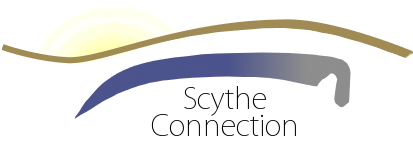"Off-set to the right" is the arrangement I suggest for all long blades (75 cm and up), especially if they are somewhat heavy (500g or more)."
A long-bladed scythe, provided it is otherwise well adjusted, can indeed function very well and be a pleasure to use EVEN if the blade is not “off-set to the right”. However, that “already good” scythe will be still nicer to use if the blade’s horizontal balance is shifted to the right by a rather uncommon principle of snath design.
I have made “wildwood” specimens incorporating this feature for about 8-9 years, and have advocated the concept widely in all of the 10 countries I’ve traveled with various demo scythes in hand. Although everyone who tried them was impressed with their feel and functionality, only a small fraction of snaths made subsequently (of wild wood or sawn lumber, either owner- made or in a production line) have incorporated this unorthodox principle. Breaking through walls of tradition has never been easy; and while this sometimes is a good thing, I wish it were different with regard to snath design.
Be that as it may, below are some examples of scythes with this favourable shift of the blade-to-the-right (of the straight line drawn between the position of the hands holding the snath).
 |
| Similar principle, less accentuated. (this snath is now in Costa Rica) |
 |
| Same snath as previous photo. |
 |
| The wooden stick shows the amount of “off-set”. Here the lower half of the snath makes a right turn only (i.e. doesn’t turn left again as in the snaths above) to accommodate the typically open-hafted blade models. This blade has a very acutely-hafted tang, (similar to #103 in our catalogue). |
 |
| Three snaths with off-sets similar to previous photo (and with Italian-made steeply hafted blades). |
 |
| The snath’s bottom end turns right and then slightly left (still requiring a more acutely hafted tang than the common German or Austrian models.) |
 |
| Ashley standing on the wall of her unfinished log cabin twirling Lance Harvell’s “4 gripper”. (described below) |
 |
| This very narrow blade (85cm length) also has a rather acute tang setting. Note how the one-grip snath also makes a slight right turn. This is the unit in action here. |
 |
| More samples of the off-set; (from right to left: with 75, 85 and 100cm blades). |
 |
| The snath with the 100cm blade and a stick indicating the actual off-set. |
 |
Sideways view of the above – in order to address two additional concepts:Firstly,
this snath is crooked in so many directions that it can be
appropriately be referred to as “curved”. However, its bottom end curves
downward – the opposite of the common curved snath models. My point in
bringing this up is that a snath does not need to have the classical S
shape curvature to work well. What is important is the relationship
between the blade’s tang angles and the curvature of the wood, as well
as the mower’s height and stance.
Second thing of note is the length of the extension (stem) on the lower grip – it is rather short; much shorter than the new generation of “ergonomic” snaths have them. I have tried to bring attention to this concept for several years now (see, for instance retrofit), but it is a somewhat uncomfortable topic among those who make and/or sell snaths. Namely, the tendency to come up with a “good for every purpose” snath (and claim it to be “the ultimate” in design) is very strong.
Admitting instead that a decidedly different grip arrangement is most suitable for trimming (with shorter blades) as opposed to field mowing (with longer blades and in somewhat lower stance/ posture) has not been popular, because it would make the scythe seller’s job more complicated and inevitably less profitable…
Be it as it may, the truth is that cutting and pushing more matter at a stroke (the natural by-product of using long blades) is notably easier if the right hand grip has a short, rather than long stem (extension).
At least some of the Swiss had that figured out long ago, because many of the mountain snath models still produced today have very short-stemmed grips.
In any case, Ashley – who is a fussy girl when it comes to scythes, and for whom I made this snath – has been pleased with how the unit functions…
(Source: Photos and text from Peter Vido, used with permission.)





No comments:
Post a Comment